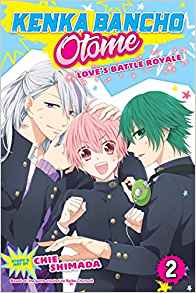Shortcake Cake, Volume 1 by suu Morishita
I’m always up for more shoujo series, and Shortcake Cake starts off with a very promising first volume. The story begins with Ten Serizawa dealing with her daily 2 hour commute to school. She gets up early and naps on the bus. But as she hangs out with her school friends, she begins to realize that her commitment to the commute means that she can’t take part in after school gatherings with her new classmates, as she has to keep checking the time to be sure she’s able to catch the last bus back to her more rural home. Ten’s friend Ageha points out how much easier it would be if Ten moved in to her boardinghouse. Ageha sneaks Ten in one day after school (the residents aren’t supposed to have outside guests), and Ten experiences the hazards of boardinghouse crashing, like avoiding the house mom, tiptoeing past the boys’ floor. In the process she has a brief encounter with the handsome bookworm Chiaki, who dazzles her with his good looks and quotes Turgenev at her.
Ten sees that the boardinghouse is much more spacious and nice than she was imagining and decides to move in. She meets another resident, the overly flirtatious Riku. As Ten gets settled in, she starts getting entwined in the lives of the residents. She sees Riku gently turning a girl down who asks him out and points out to him that if he would stop flirting with everyone, random girls wouldn’t get the wrong idea. Riku’s ingratiating manners are looked on as odd by most of the boardinghouse. Riku starts falling for Ten, and can’t act like his normal self around her anymore. The new friends go out on an outing, and Ten learns more about Chiaki’s bookish ways and his reactions to his looks-driven popularity. Finally, a third boy is introduced, Rei, who wears traditional clothing and is drawn to resemble a blond L from Death Note. He’s given to odd insulting outbursts.
So a romance being set up where many people slowly fall in love with a relatively ordinary girl is familiar shoujo manga territory, but the situation in Shortcake Cake doesn’t feel artificial or unearned, because Ten is objectively pretty adorable with her Sailor Moon style pigtails and her quirky hobby of following along with radio exercise programs. Morishita does a great job with character development in this volume, leaving just enough mystery for the reader to become invested in finding out why Chiaki is so withdrawn and wonder why Riku is overcompensating by acting superficially pleasant to most of the girls he meets. The volume ends on a cliffhanger which shows Ten forcing a confrontation about something that most shoujo heroines would leave unsaid for 5-6 volumes, which instantly got me onboard for the rest of the series!
Morishita’s art features a liberal amount of screen tone, and her characters quickly switch back and forth between regular and exaggerated facial expressions. Ten frequently shifts into cat face mode whenever she’s being mischievous or startled. The production for Shortcake Cake sets it apart from other Shojo Beat volumes, with matte covers and a cute strawberry on the spine. There are some additional black and white illustrations for chapter covers included as a bonus in the back of the book. I can see why this shoujo series was so highly anticipated, and I’m looking forward to reading more.





Recent Comments